| History | |
|---|---|
| | |
| Name | SS Ina Mactavish |
| Builder | Burrell & Son, Glasgow |
| Launched | 1886 |
| Homeport | Glasgow |
| Fate |
|
| General characteristics | |
| Tonnage | 107 tons |
| Crew | 4 |
SS Ina Mactavish was a small coaster that was wrecked in 1907 with the loss of two lives.
| History | |
|---|---|
| | |
| Name | SS Ina Mactavish |
| Builder | Burrell & Son, Glasgow |
| Launched | 1886 |
| Homeport | Glasgow |
| Fate |
|
| General characteristics | |
| Tonnage | 107 tons |
| Crew | 4 |
SS Ina Mactavish was a small coaster that was wrecked in 1907 with the loss of two lives.
Ina Mactavish was built by Burrell & Son of Glasgow in 1866. She spent the next twenty years as a coasting lighter before sinking in 1906. She was bought by Clyde Salvage Company for £175, and another £800 was spent lengthening and repairing her. This work was carried out by the Ardrossan Dry Dock and Shipping Company. In February 1907, she was sold to John Wilson of Leith for £1,450. [1]
Ina Mactavish left South Shields on the River Tyne on the morning of 16 October 1907 bound for Aberdeen, laden with 130 tons of lime. At about 22:00, the ship's condenser broke down as a nut had come off the suction valve. Around 06:00 on 17 October, the engines were stopped because a rope had become entangled around the propeller. It was decided to beach the ship, and shortly before 09:00 the ship grounded to the south of Birling Car Rock in Alnmouth Bay. It took until 15:00 for the Alnmouth lifeboat to rescue the survivors. By this time the ship's engineer and cook had both drowned. [1] For their part in trying to rescue the crew, P. Holbert, chief boatman of coastguard, Amble; A. Barton, Police Sergeant, of Amble and J. Helm, police constable of Warkworth were each awarded a Sea Gallantry Medal. [2]
The wreck was towed into Amble, and later sold off for £515. [1]
An inquiry was held by the Board of Trade at the Moot Hall, Newcastle upon Tyne in December 1907 and February 1908. The master of the vessel was found not to have caused the accident, but was reprimanded for not sending out a distress signal when the ship's engines were stopped. It was also noted that there was a long delay between the wreck being observed and the lifeboat being launched. [1]

Cadgwith is a village and fishing port in Cornwall, England, United Kingdom. It is on the Lizard Peninsula between The Lizard and Coverack. It is in the civil parish of Grade Ruan.

Rohilla was a passenger steamer of the British India Steam Navigation Company which was built for service between the UK and India, and as a troopship. After becoming a hospital ship in the First World War, She ran aground in October 1914, near Whitby, with the loss of 83 lives.
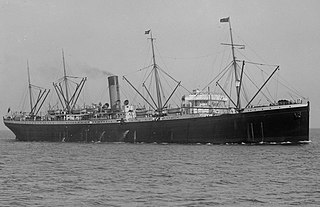
SS Suevic was a steamship built by Harland and Wolff in Belfast for the White Star Line. Suevic was the fifth and last of the Jubilee-class ocean liners, built specifically to service the Liverpool-Cape Town-Sydney route, along with her sister ship Runic. In 1907 she was wrecked off the south coast of England, but in the largest rescue of its kind, all passengers and crew were saved. The ship herself was deliberately broken in two, and a new bow was attached to the salvaged stern portion. Later serving as a Norwegian whaling factory ship carrying the name Skytteren, she was scuttled off the Swedish coast in 1942 to prevent her capture by ships of Nazi Germany.
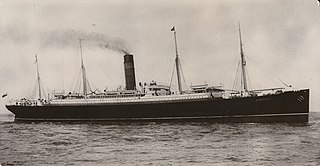
RMS Carpathia was a Cunard Line transatlantic passenger steamship built by Swan Hunter & Wigham Richardson in their shipyard in Wallsend, England.
SS Hong Moh was a passenger ship that was wrecked on the White Rocks off Lamock Island, Swatow, on 3 March 1921 with the loss of about 900 lives.
SS Empire Clansman was a 2,065 ton collier which was built in 1942 for the Ministry of War Transport (MoWT). She saw service mainly in British coastal waters during the Second World War, before running aground and being badly damaged in 1945. She was subsequently salvaged and returned to service for several companies after the war, under the names Sheaf Field, Corfield and then Spyros Amrenakis, before being wrecked for a second and final time in 1965.
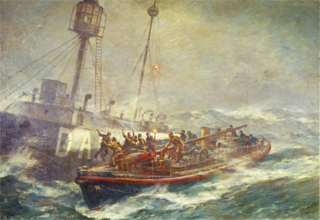
RNLB Mary Stanford was the Ballycotton Lifeboat from 1930 to 1959. Ballycotton is on Ireland's southern coast, a trade route to the Americas. There are many dangerous rocks and shallows with on-shore prevailing winds. Ballycotton has a long tradition of life-saving. Mary Stanford had 41 rescues, or "shouts", and saved 122 lives. She performed the notable Daunt Lightship rescue on 11 February 1936. After her withdrawal from service she lay for some years in a backwater of Dublin's Grand Canal Dock, but has now been returned to Ballycotton and restored.

SS Monte Nevoso was a cargo steamship that was launched in 1920 in England, owned in Italy, and wrecked in 1932 in the North Sea off the coast of Norfolk.
SS Gallois was one of seven merchant vessels which became stranded and then wrecked on Haisbro Sands of the Norfolk coast on 6 August 1941 during the Second World War. The SS Gallois had been part of a convoy with the designation Convoy FS 559.
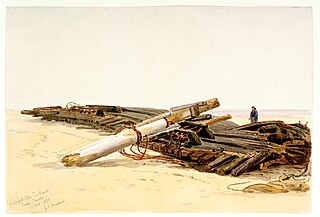
Ellen Southard was an American full-rigged merchant ship from Bath, Maine that was built in 1863 by prominent shipbuilder T.J. Southard. She plied international trade routes for twelve years, calling at ports as far away as Sydney.

RNLB Foresters Centenary is a retired Liverpool-class lifeboat of the Royal National Lifeboat Institution (RNLI), stationed in the English coastal town of Sheringham in the county of Norfolk in the United Kingdom. The lifeboat was on station for 25 years between 1936 and 1961 when she was sold. She has been restored to her original condition and is exhibited in Sheringham Museum.
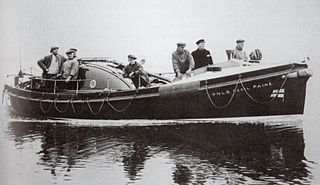
RNLB Cecil Paine is a retired Liverpool-class non-self-righting lifeboat of the Royal National Lifeboat Institution. It was the second motor lifeboat to be stationed in the English coastal town of Wells-next-the-Sea in the county of Norfolk in the United Kingdom, and was on station at Wells from 25 July 1945 until she was sold in June 1965.

RNLB Abdy Beauclerk was a 41ft Watson-class lifeboat which was stationed in the town of Aldeburgh in the English county of Suffolk. She was on the No: 1 station at Aldeburgh from 1931 until she was sold out of the RNLI fleet in 1959, a total of 28 years service.

Walton and Frinton Lifeboat Station is an RNLI station located in the town of Walton-on-the-Naze in the English county of Essex. The current all-weather boat (AWB) at Walton is the Tamar Class Irene Muriel Rees which is kept moored afloat in a specially constructed pen at the end of Walton Pier. Prior to the construction of this, the boats were anchored in open water to the south of the pier.

RNLB Emma Constance was a Barnett-class lifeboat stationed at Aberdeen Lifeboat Station, in the Scottish city of Aberdeen from 1927 until August 1951. The lifeboat was designed by James R. Barnett who was a consulting naval architect to the Royal National Lifeboat Institution (RNLI).
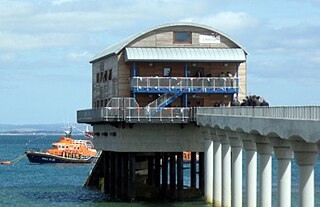
Bembridge Lifeboat Station is an RNLI station located in the village of Bembridge on the Isle of Wight in the United Kingdom.

Shoreham Harbour Lifeboat Station is a Royal National Lifeboat Institution (RNLI) station located in the town of Shoreham-by-Sea in the English county of West Sussex. It underwent extensive re-development in 2010 with a new purpose built boathall to accommodate its new Tamar-class all-weather lifeboat (AWB). It operates two lifeboats, the AWB RNLB Enid Collett (ON 1295) and the D-class (IB1) Inshore lifeboat RNLB Joan Woodland (D-784).

Eastbourne Lifeboat Station is a Royal National Lifeboat Institution (RNLI) lifeboat station in the town of Eastbourne in East Sussex. Founded two years before the RNLI was established, the station has operated continuously since 1822 and its lifeboats have been responsible for saving over 700 lives. There are two active lifeboat stations in Eastbourne, an all-weather station with the Tamar-class lifeboatDiamond Jubilee at Sovereign Harbour and the D-class Lawrence and Percy Hobbs at the inshore lifeboat station a couple of miles to the west at Fisherman's Green. An older lifeboat station, west of Eastbourne Pier, is now used as an RNLI museum.
SS Stolwijk, a Dutch cargo ship of 2,489 tons, was wrecked off the coast of Donegal on 6 December 1940. She was part of a Convoy SC 13 sailing from the Dominion of Newfoundland to Liverpool, England, when her rudder was damaged in a fierce storm. Attempts to rescue her by her destroyer escort failed and she went on the rocks off Tory Island, County Donegal, Ireland. Ten of her crew were lost but the remaining 18 were rescued the following day by Arranmore Lifeboat and landed safely in Burtonport. The rescue of the survivors was conducted in terrible weather conditions and both the RNLI and Queen Wilhelmina of the Netherlands awarded medals to the Irish lifeboat crew.

The SS Fernebo was a Swedish cargo ship that was built in 1912. She was wrecked off Cromer, Norfolk, in England on 9 January 1917, being split in two by a boiler explosion or a German sea mine. Her chief engineer was killed but the remaining 17 crew members were rescued by onlookers and the Cromer lifeboat, commanded by Henry Blogg. Part of her wreck remains on the beach at Cromer but is only visible at extremely low tides.